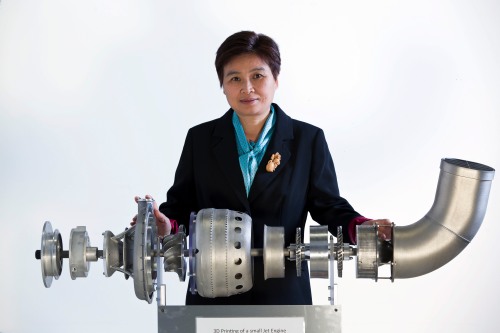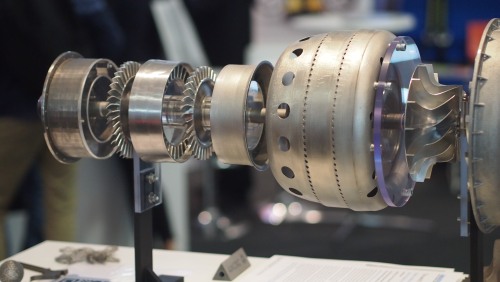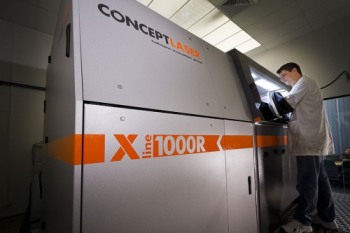 |
| March 17, 2015 | Volume 11 Issue 11 |
Designfax weekly eMagazine
Archives
Partners
Manufacturing Center
Product Spotlight
Modern Applications News
Metalworking Ideas For
Today's Job Shops
Tooling and Production
Strategies for large
metalworking plants
Wings:
3D-printed jet engine is big leap forward for additive manufacturing
3D printing final parts in metal has taken a big leap forward when it comes to aviation.
A group of researchers at Monash University in Australia, along with international collaborators, has printed all of the major parts for a jet engine. In fact, Monash and their spin-out company Amaero have printed two engines. One was on display in late February at the Avalon International Air Show at Avalon Airport, in Victoria, Australia, while the second is on display in Toulouse, France, at the French aerospace company Microturbo (a division of Safran).

Professor Xinhua Wu with the printed engine. [Credit: Monash University]
We've all heard a lot about 3D printing lately, and even we at Designfax have to admit that sometimes the headlines are not indicative of the true state of affairs of the technology's progression. In terms of 3D-printed cars, for example, it is usually the frame and body that are printed. The main components to run the vehicle are not. And traditionally, 3D printing has been used to great advantage for prototyping, not for end-use parts. But there have been exceptions and progressions.
NASA printed and tested finished-product propellant injectors for a rocket engine in 2013, for example, but certainly not all of the major components for the actual engine. But the project was still a milestone. According to a statement released by NASA to the public about that project, "One of the keys to reducing the cost of rocket parts is minimizing the number of components. This injector had only two parts, whereas a similar injector tested earlier had 115 parts. Fewer parts require less assembly effort, which means complex parts made with 3D printing have the potential for significant cost savings." Because 3D printing can create designs that can't be cast or molded, it sets itself apart when it comes to integrating multiple features into a single piece and also for lightweighting.
In the case of the Monash 3D-printed engine, just printing one or two engine components is not the case. All of the major components for the small gas-turbine engine have been produced using additive manufacturing, and the impressive next-stage goal is to get this actual engine firing. Granted, there are pieces to put the final working engine together that have not been made using 3D printing. They did not 3D print the fastener elements, for example. But that really makes this effort no less impressive.

Printed jet engine. [Credit: Science in Public]
"The project is a spectacular proof of concept that's leading to significant contracts with aerospace companies. It was a challenge for the team and pushed the technology to new heights of success -- no one has printed an entire engine commercially yet," says Ben Batagol, of Amaero Engineering, the company created by Monash University to make the technology available to Australian industry and some worldwide partners.
The two Monash engines are a proof of concept that's led to tier-one aerospace companies lining up to develop new components at the Monash Centre for Additive Manufacturing (MCAM) in Melbourne, Australia. And the project has created advanced manufacturing opportunities for Australian businesses large and small.
To get the project off the ground, small-turbojet specialist Microturbo provided an older -- though still in service -- gas turbine engine as the base model to be copied. It's an auxiliary power unit used in aircraft such as the Falcon 20 business jet and was chosen because Microturbo was willing to have its internal workings displayed in all their full glory. Not every jet component and engine manufacturer would be willing to do the same.
"It was our chance to prove what we could do," says Professor Xinhua Wu, the director of the Monash Centre for Additive Manufacturing (MCAM). "But when we reviewed the plans, we realized that the engine had evolved over years of manufacture. So we took the engine to pieces and scanned the components. Then we printed two copies."
It was a complex project that took a year and funding from Monash University, the Science and Industry Endowment Fund (SIEF) in Australia, and others. The timeline now to get the engine firing after fully testing all of the parts is two years.
MCAM's work on printing the jet engine has progressed from using the original "instructions" for the engine to assessing the engine section by section, determining which parts are most cost effective if 3D printed, and which are still best built the traditional way. During this process, they have also been investigating what parts of the engine can be lightened, while still ensuring any part meets all safety certifications.

Printing in metal. One of the metal laser printers at the Monash Centre for Additive Manufacturing. [Credit: MCAM]
Monash researchers are currently working with a number of companies, mainly preparing prototypes of components that they're interested in developing further, and doing feasibility studies for them as to whether this method of manufacture is going to make sense for scale-up.
They have also been commissioned to make hundreds of prototype fuel injectors, which are being test-fired by Safran. Other tier-one aerospace companies are commissioning Amaero, including Raytheon and Boeing.
MCAM uses two methods of additive manufacturing: powder-bed selective laser sintering (commonly referred to as 3D printing) and blown-powder laser-melting. They work from computer-aided design (CAD) files, using the printing machines to go directly to a product.
The information in the following two sections about additive manufacturing materials has been provided by Monash. The videos are also courtesy of Monash.
Powder-bed 3D printing
The Centre has a Concept Laser XLine (the largest powder bed selective laser-melting (SLM) machine available) and two EOS INT 280M powder-bed SLM machines. Parts up to 650-mm x 400-mm x 500-mm deep can be produced.
The parts can have complex shapes and can include honeycombed internal structures to reduce weight and cost.
The powder-bed method involves metal powder spread in a very thin layer (50 microns, in the ballpark of the width of a human hair) across a base plate, where a laser fuses the metal in an outline determined by the computer-aided design. The base plate then drops by 50 microns, and the process is repeated to build up the structure -- adding, rather than removing components as in some other manufacturing methods. There is a small amount of spatter (powder that is melted but hasn't attached properly onto the product). This is caught and sieved to be recycled, so there is a very small amount of wastage.
Video: EOS INT 280M powder bed machine running.
Blown-powder printing
The Centre also has a Trumpf 7040 Laser Cell Blown-Powder facility that can house parts up to 4,000 mm x 1,500 mm x 750 mm.
This second method is more flexible in terms of the possibilities for shapes and its potential to add to or repair existing structures such as damaged turbine blades. The metal powder is melted when blown into a laser, being deposited beneath while the mounted laser head moves around in a spiral.
The Centre can produce parts with short lead times (in weeks rather than months) using:
- Nickel-based alloy (Hastelloy X) for high-temperature applications, such as the hot parts of gas turbine engines, heat exchangers, combined cycle power plants.
- High alloy stainless steel for high-strength, highly corrosion-resistant applications in oil and gas and chemical processing plants.
- Eighteen percent Ni Maraging 300 harden-able steel for injection-molding tooling and very high-strength airframe parts.
And on longer time frames they can use lightweight, high-strength aluminum and titanium alloys for aerospace structures and marine uses; medical devices, and prosthetics.
Video: 3D printing using selective laser-melting.
Video: Concept Laser XLine 3D printing machine running.
Sources: Monash University, Science in Public
Published March 2015
Rate this article
View our terms of use and privacy policy
